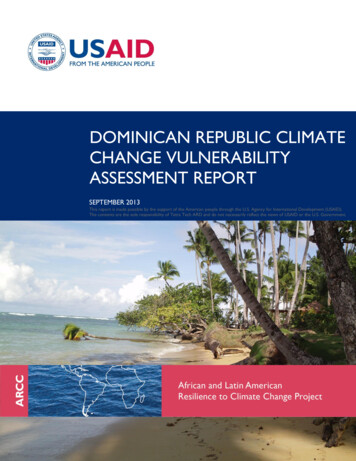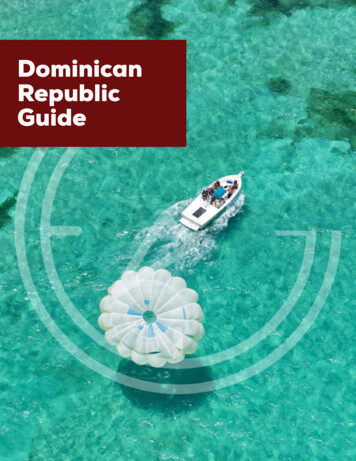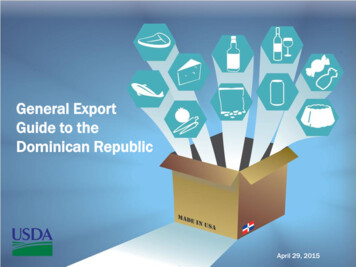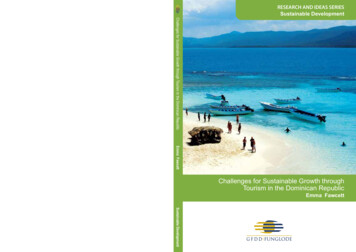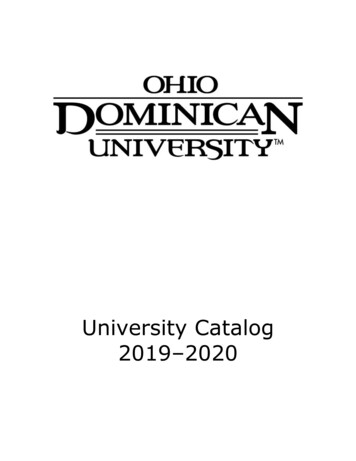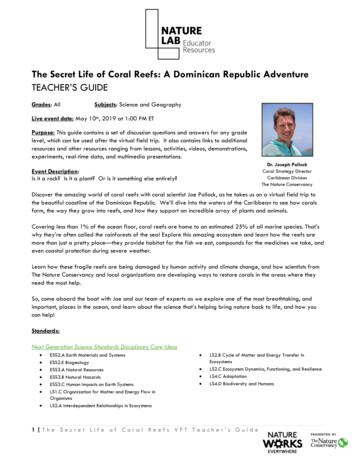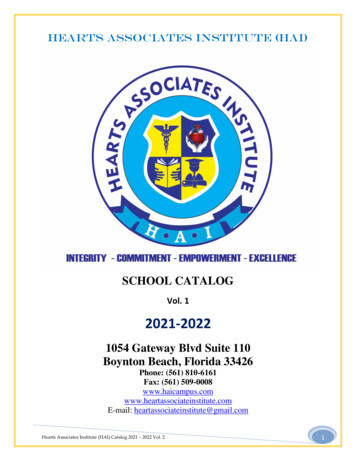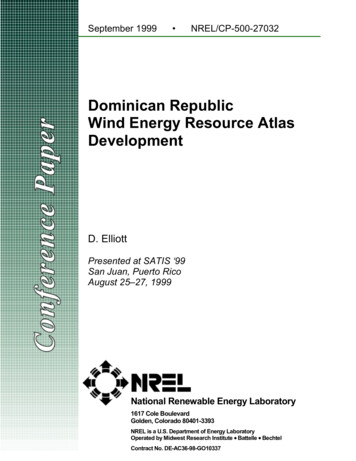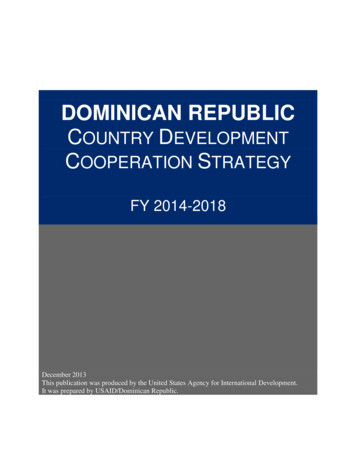
Transcription
DOMINICAN REPUBLICCOUNTRY DEVELOPMENTCOOPERATION STRATEGYFY 2014-2018December 2013This publication was produced by the United States Agency for International Development.It was prepared by USAID/Dominican Republic.
ContentsExecutive Summary . 3Development Context . 7Country Overview and Development Challenges . 7U.S. Foreign Policy Alignment . 11Alignment with Host Country Development Priorities. 13Development Hypothesis . 13Goal: The Dominican Republic Improves Citizen Security to Promote Economic Growth . 13Development Objective 1: Crime Prevention Strengthened . 17Development Objective 2: Increased Resilience of People to the Impact of Climate Change . 30Development Objective 3: AIDS-free Generation Advanced. 38Annexes . 47Annex 1: Results Framework. 47Annex 2: Acronyms and Abbreviations . 48Annex 3: Reference List . 50Annex 4: USAID/Dominican Republic Consultations . 522
Executive SummaryIn preparing this Country Development Cooperation Strategy (CDCS), the Mission held morethan 40 meetings with stakeholders from the Government of the Dominican Republic (GODR),civil society, implementing partners, the private sector, bilateral and multilateral donors,Dominican private sector foundations, church leaders, and United States Government (USG)partners. 1 The Mission made a special effort to talk directly with beneficiaries. We met withbeneficiaries in hospitals, HIV/AIDS treatment centers, bateyes (poor, rural communitiesinhabited primarily by Haitian sugar cane plantation workers), with community leaders andyouth in urban slums, and with clients of community justice houses. The Mission proactivelyreached out to vulnerable groups, in particular people with disabilities, the Lesbian, Gay,Bisexual and Transgender (LGBT) community, women, and youth at risk, so we could hear fromthem, first hand, their needs and priorities.Problem StatementThroughout the consultation process that guided the development of this strategy, citizen securitywas identified by the Dominicans as a significant challenge to economic growth anddevelopment. Citizen security has myriad characterizations, but this strategy applies thedefinition promulgated at the 2012 Summit of the Americas of ‘a democratic civic order thatremoves the threats posed by violence in the population and enables secure and peacefulcoexistence. It concerns, in essence, the effective safeguarding of a broad range of humanrights including, among others, the right to personal safety, freedom of movement, and theenjoyment of heritage .’In addition to advancing social freedoms and well-being, increasing citizen security by reducingcrime has a positive effect on investment and therefore sustains and promotes economic growth.A 2005 United Nations Development Program (UNDP) study found that 63 percent of firms inthe Dominican Republic cited crime as a major obstacle to investment. A 2007 UNDP studyconcluded that crime leads to reduced economic growth. The study noted that crime and theperception of crime can contribute to public sector funds being diverted from productiveinvestments to crime prevention measures and divert private funds from investment in businessexpansion to security improvements to protect existing investments (security guards, alarmsystems). The study concluded that economic growth would have increased in the DominicanRepublic by 1.8 percent if the GODR had been able to bring its homicide rate down to the levelof Costa Rica. Therefore, increasing citizen security by reducing crime can also contribute topromoting economic growth.1GODR on at least two occasions, persons with disabilities, LGBT, GBV organizations, private sector, implementingpartners.3
Goal: The Dominican Republic Improves Citizen Security to Promote Economic GrowthBased on extensive consultations with Dominican colleagues, other donors, and implementingpartners, USAID/Dominican Republic adopted as its overarching goal to work with Dominicansto improve citizen security in order to promote economic growth. To help the Dominicansachieve this goal, USAID/Dominican Republic identified three sectors where it will work. Eachof these sectors has a corresponding Development Objective that is described below.Development Objective (DO) 1: Crime Prevention StrengthenedUSAID/Dominican Republic will pursue a tripartite approach to crime prevention. It will 1)work with at-risk youth in the country’s poorest, most violent, and most densely populated urbanareas; 2) improve the basic reading skills of students in targeted poor neighborhoods; and 3)implement systemic reforms to the criminal justice system. Our objective will be to decrease thevulnerability of at-risk youth by keeping them in or reinserting them into school, as well ashelping them to find gainful employment through vocational education in sectors projected togrow in the Dominican economy. To keep children in school, USAID/Dominican Republic willfocus on strengthening schools in the targeted neighborhoods and encouraging the GODR toexpand the USAID-piloted Effective Schools Program (ESP) nationwide. The ESP program hasgenerated learning gains among participants that are significantly greater than those of nonparticipants, and garnered support from the private sector as well as the GODR. Complementingthe improved reading program in primary schools, USAID/Dominican Republic will also supportremedial and supplemental reading programs in targeted neighborhoods. At the systemic level,the GODR will be assisted to implement key police reforms and strengthen key justiceinstitutions. The combination of systemic improvements in the justice system, which lead toincreased responsiveness of the justice sector to citizen needs, and a drop in crime in the mostcrime-ridden neighborhoods in the country, should help to create an improved sense of citizensecurity.Development Objective 2: Increased Resilience of People to the Impact of Climate ChangeUSAID/Dominican Republic will work to increase the resilience of people to the impacts ofclimate change, thereby reducing physical insecurity and economic losses caused by the havoc ofclimate change-induced severe weather events and sea level rise. Specifically,USAID/Dominican Republic will develop and improve municipal land use planning to integrateclimate change information and increase the adoption of adaptation measures at the local level,with a particular focus on water source protection and disaster risk reduction in Santo Domingoand Santiago, the two most populous cities in the country. These urban areas are home to themajority of the country’s population and reflect the Mission’s concentration on reducing thevulnerability of these marginalized populations. The program will also work in two or threetargeted coastal towns, where the tourism industry is already at risk because of climate changeimpacts, and in selected rural areas that have already suffered the impacts of disasters and globalclimate change.4
Development Objective 3: AIDS-Free Generation AdvancedUSAID/Dominican Republic will implement programs to help prevent the spread of HIV/AIDS,improve care for persons with HIV/AIDS, end stigma and discrimination against HIV/AIDSvictims and the LGBT community, and reduce gender-based violence (GBV). These efforts willhelp increase personal security for these vulnerable groups.Geographic FocusCrime prevention and Global Climate Change programs (DOs 1 and 2) will focus primarily onthe corridor that runs from Santo Domingo north to Puerto Plata. It includes six of the nation’s32 provinces, 70 percent of the Dominican population, and 63 percent of the country’s youth.The cities where crime is the highest in the Dominican Republic all also lie within this corridor.2For HIV/AIDS, the location of key populations guide where HIV/AIDS investments and servicesneed to be offered, and therefore, DO 3 will not be geographically focused.Cross-Sectoral Themes: Transparency and Inclusion of Marginalized PopulationsThroughout the implementation of this CDCS, there are two cross cutting issues that affect all sectors:1) transparency and accountability and 2) addressing the needs of marginalized populations.USAID/Dominican Republic will support a limited number of key systemic reforms to promotetransparency across ministries and has identified within each of the Development Objectivespotential areas where USAID/Dominican Republic’s investments can contribute to greatertransparency. To address the needs and protect the rights of marginalized populations, includingwomen, people without official identification documents, the LGBT community and people withdisabilities, USAID/Dominican Republic will also identify opportunities to protect and promotetheir rights with systemic and sector-specific approaches.ResultsWorking in concert with like-minded stakeholders, by 2018, USAID/Dominican Republicinvestments will: Help more than 80,000 youth aged 11-24 to finish school, receive vocational training,find jobs, and develop better life skills;Help more than 60,000 people through crime prevention at the community level;Improve reading skills of 100,000 students in 400 public primary schools;Enable four municipalities (including the major cities of Santo Domingo and Santiago) toincorporate climate change information into their land use planning, reducingvulnerability to natural disasters;Reach 60,000 at-risk youth through programs in HIV prevention and sexual andreproductive health;2Locations with the highest rates of crime are noted here. For robberies: National District, Puerto Plata, Santiago,San Cristobal and Santo Domingo. For assaults: National District, La Romana, San Cristobal, Santiago, and SantoDomingo. Kidnappings: National District, San Cristobal, Santiago, Santo Domingo, and La Vega. Rape: Barahona,Peravia, and Santo Domingo.5
Reduce the HIV Mother to Child transmission rate to below two percent; andReduce the HIV prevalence rate in key populations to below three percent.Policy DialogueUSAID/Dominican Republic would be significantly underestimating the impact it can have if itdid not factor in what can be accomplished, without any investment of money, through asystematic approach to policy dialogue. During the next five years, outside of the sectoralconfines of the DOs, USAID/Dominican Republic will initiate dialogue to ensure thatinvestments USAID, and others, have made are sustainable and fully adopted by the GODR. Afew of the results expected from USAID/Dominican Republic’s systemic policy dialogueinclude: Ministry of Education (MOE) adopts the USAID funded Effective Schools Programteaching methodology for reading and math nationwide;Ministry of Health expands the USAID funded Centers of Excellence for Maternal andChild health program nationwide;Performance-based budget planning methodology expanded from Health, Education,Labor and Finance Ministries to other Ministries;The Ministry of Education makes new classrooms accessible to students with specialneeds and develops a curriculum and teacher training that encourages special needsstudents to attend school;The Ministry of Health’s planned renovation of 36 hospitals incorporates universaldesigns for accessibility; andThe Ministry of Health assumes increasing financial responsibility for funding HIVservices.USAID/Dominican Republic’s ability to initiate policy dialogue simultaneously on so manyfronts is a testament to the cumulative efforts, and consequent influence, of all theUSAID/Dominican Republic staff who have worked over the last 50 years for the benefit of theDominican people. During the course of this strategy, USAID/Dominican Republic’srelationship with the GODR will continue to evolve as a relationship of partners, dedicated to themutual security and economic prosperity of both nations.6
Development ContextCountry Overview and Development ChallengesThe Dominican Republic is the Caribbean region’s largest economy with a gross domestic product(GDP) in 2012 estimated to be 98.74 billion (three times the size of Guatemala’s). The Dominicaneconomy, which had experienced impressive growth over many years, has slowed since 2011, from agrowth rate of 4.5 percent in 2011 to 3.9 percent in 2012 and a projected 3 percent growth rate in20133.The Dominican Republic’s projected growth rate (3.8 percent) for 2013 is higher than theCaribbean average of 3.5 percent, and the projected growth rate of Haiti (6 percent), Nicaragua, Chile,and Bolivia (5 percent), Ecuador (3.5 percent), Honduras (3.3 percent) and Guatemala (3.2 percent)4.Source: Economist Intelligence UnitInequalityThe Dominican Republic is classified as an upper middle income country. However, the country’seconomic progress masks high levels of inequality that permeate Dominican society. Forty percent ofthe population receives less than 10 percent of the country’s wealth, while the wealthiest 10 percentaccount for more than 40 percent of the country’s income.5 More than 40 percent of the Dominicanpeople live in poverty. The Gini coefficient, which measures a country’s income equality (on a scale of0-100, with higher being more unequal), for the Dominican Republic is 47.26 in 2012, better than itwas in 2000 at 52, but worse in comparison to other countries in Latin America: El Salvador 46.9; Peru46.0; Argentina 45.8; Nicaragua 40.57.A nation’s prosperity also correlates with the level of parity between women and men, and therecontinues to be considerable gender inequality in the Dominican Republic. In 2012, the DominicanRepublic received an overall ranking of 89 out of 135 countries in the World Economic Forum’s (WEF)3Central Intelligence Agency (CIA) World Factbook 2012. /geos/dr.html4Economic Commission for Latin American and the Caribbean (ECLAC), Updated Economic Overview of Latin Americanand the Caribbean, 2012.5Economic Commission for Latin America and the Caribbean. Social Panorama of Latin America, 2012, news articleNovember 28, 2012.6CIA World Factbook 20127Ibid.7
Gender Gap Index.8 The Dominican Republic’s ranking has steadily declined since 2009, when itranked 67 out of 134 countries. According to the Inter-American Development Bank (IDB), there isalso a gender salary gap of 16 percent, indicating that women receive lower salaries for the same work.UnemploymentA gender gap also exists in terms of unemployment. From 2003 to 2011, the average unemploymentrate among men was 9.9 percent, while for women it was 25.3 percent.9 In 2011, 14.6 percent of thecountry’s 4.5 million workers, or 668,000 people, were unemployed.10 In 2012, the nationalunemployment rate dropped slightly to 13 percent, but youth unemployment exceeded 30 percent.Crime and ViolenceThe fear of crime is palpable in the Dominican Republic. In 2012, 65 percent of the populationreported feeling less secure than they did five years ago.11 Crime statistics validate that the fear isjustified. Homicide rates in the Dominican Republic have almost doubled from 2002 to 2012, from 14 to 24per 100,000 people, making it the fourth most violent country in the Caribbean. According to the 2012Latin American Public Opinion Project (LAPOP) survey, 25 percent of Dominican Republic citizensreport having been robbed or assaulted in the last year.12Gangs and drugs are also major concerns. In the 2012 LAPOP survey, the Dominican Republic isranked first of all countries in Latin America and the Caribbean in terms of people reporting that theirneighborhoods were affected by gangs (48.6 percent in the Dominican Republic vs. 29.6 percent inHonduras). While the characteristics, power, and actions of gangs vary dramatically throughout theregion, this nevertheless represents a troublesome perception for Dominicans. In 2012, 27.9 percent ofthe Dominican population reported seeing the sale of drugs in their neighborhood, up from 18.4percent in 2008. According to the Dominican Attorney General’s Office, during the period 2005 toMay 2012, 40.6 percent of crimes were drug related. In 2009, more than 24,000 drug-related arrestswere made in the Dominican Republic, of which 70 percent (17,000 people) were young offenders.Drug trafficking is also on the rise. According to the National Office of Drug Control, drug seizureshave more than tripled between 2008 and 2012, and for 2013, in just three weeks, seizures werealready at 25 percent of 2012 levels. While this may indicate improved interdiction, it may also be theresult of greater drug trafficking along routes through the Caribbean and the increased presence oftransnational criminal organizations from Mexico and Central and South America operating inDominican territory.Violence against WomenAlthough there are no national statistics on GBV, Dominicans have expressed their perception andvoiced their concern that the incidence of GBV is extensive and on the rise. In December 2012, the8World Economic Forum, 2012 Gender Gap Report. http://www3.weforum.org/docs/WEF GenderGap Report 2012.pdfDominican National Office of Statistics (Oficina Nacional de Estadisticas)10Dominican Central Bank11AmericasBarometer 201212DR1 Daily News report, June 21, 2011. www.dr1.com98
Attorney General stated that the number of GBV complaints filed in Santo Domingo in 2012 hadnearly doubled over 2011, and that 85 percent of these cases had been filed by women aged 18-35.According to the 2007 Demographic Health Survey (DHS), 9.7 percent of women aged 15 - 49experienced physical violence and 10.1 percent experienced sexual violence in 2007.13 In addition,29.8 percent of women ages 15 - 49 reported at some point in their lives being victims of domesticabuse.Of those who had experienced sexual violence, 38.5 percent experienced their first aggressionbefore the age of 20, with 6.5 percent of respondents stating they were younger than 10 years old whenthey first experienced sexual violence.14The Dominican Republic is also identified as a source, transit and destination country for sextrafficking and forced labor by the U.S. Department of State’s 2012 Trafficking in Persons Report.Dominican trafficking is widespread, and victims have been found in or repatriated from 18 countriesaround the world, primarily in the Americas and Europe. Between 2007 and 2010, Dominican victimsaccounted for about 1 percent of the victims detected in Western and Central Europe and about 3percent of the victims detected in the Americas.15Exclusion and DiscriminationIn the Dominican Republic, the poor, people with disabilities, persons infected with or affected by HIV,undocumented Dominicans and Haitians, women, and members of the lesbian, gay, bisexual, andtransgender community suffer from discrimination and exclusion from Dominican society.Estimates of the number of Haitians living in the Dominican Republic vary widely, from as low as450,000 to a high of 1.2 million16. Undocumented Haitians living in the Dominican Republic havecomplained of living in fear of being deported, abused by authorities, exploited by employers andunable to register and start their own businesses. Undocumented children, including those of Haitiandescent can attend primary school, but cannot attend secondary school. There is growing recognitionthat Haitians, or Dominicans of Haitian descent, are discriminated against and have unequal access tomany social services. The 2012 LAPOP survey reported that 60.6 percent of Dominicans believe thatimmigrants should be able to access Dominican public services.Another excluded group is people with disabilities. There is a sizable Dominican population with somekind of disability. The 2010 Dominican Census indicated that 12.3 percent of the population, or 1.1million people, have some kind of disability. Most people with disabilities are not working and theiraccess to education has been severely limited because most buildings and schools are not physicallyaccessible. A United Nations Educational, Scientific, and Cultural Organization (UNESCO) study,published in December 2012, reported that 70 percent of children with a disability were currently notin school.Demographic Health Survey 2007. -display-291.cfmIbid.15"Global Report on Trafficking in Persons 2012." United Nations Office of Drugs and Crime, Dec. 2012. Web. 24 June2013. lotip/Trafficking in Persons 2012 web.pdf 16European Union, UNFPA, Officina Nacional de Estadistica, Primera Encuesta Nacional de Inmigrantes en la RepublicDominicana ENI-2012, 201213149
These vulnerable groups, which amount to a sizable percentage of the Dominican population, live onthe margins of Dominican society. Taking into consideration the population disenfranchised becausethey have a disability, the population excluded because they are undocumented, the young peopleunemployed, Dominicans who live below the poverty line, the LGBT community, and people affectedby and infected with HIV/AIDS, a sizable portion of the Dominican population are directly affected bycitizen security issues that extend well beyond just the issue of being a crime victim. Excluding thesegroups from the benefits generally enjoyed by other Dominicans can pose its own unique citizensecurity and stability issues.Poor Business EnvironmentToday, the Dominican Republic stands at 137 out of 185 economies on the ease of startinga business.17 The Dominican Republic’s economic freedom score was 60.2 in 2012, making itseconomy the 89th freest of 161 countries analyzed and, within the South and Central America andCaribbean region, the Dominican Republic is ranked 18th out of 29 countries. The chart below, fromthe 2013 Democracy, Human Rights, and Governance Assessment for the Dominican Republic, showsvarious obstacles to investment cited by the private sector. Common obstacles cited in both studies arecorruption and crime.CHART 4.1.8-2, OBSTACLES TO INVESTMENT AND DOING BUSINESS IN THE DOMINICANREPUBLICWORLD BANK INVESTMENTCLIMATE SURVEY, 2005ElectricityCorruptionCrimeMacroeconomic InstabilityUncertain policies and regulationsAnticompetitive informal policiesGLOBAL COMPETITIVENESSREPORT, 2012-2013CorruptionInefficient government bureaucracyAccess to financingTaxesInadequately educated workforceCrimeAccess to and cost of financingRestrictive labor regulationsSources: World Bank, World Economic Forum.Note: Issues in both surveys are listed in the order of their stated importance.CorruptionIn the 2012 LAPOP survey, 78 percent of Dominicans indicated that corruption was a problem. TheWorld Economic Forum ranked the Dominican Republic the worst in the world in terms of wastefulgovernment spending (144th of 144 countries) and 142nd in terms of diversion of public funds.181718World Bank. Doing Business 2013 Country Profile for Dominican Republic.World Economic Forum’s Global Competitiveness Report 2012-201310
Unreliable ElectricityThe Dominican Republic has the highest priced energy in the region. The inefficient supply ofelectricity and ineffective governance of the sector suppresses overall economic growth in theDominican Republic19.Negative Impacts of Climate ChangeThe Dominican Republic is one of the ten most vulnerable countries in the world to climate change.20It is also prone to a variety of natural disasters including hurricanes, earthquakes, floods, and landslides,which can severely impact such a small economy. Sea level rise, warmer weather, and more frequentflooding are global climate change symptoms that are already affecting the Dominican Republic and willcontinue to negatively impact Dominican development prospects. One study predicted that due to sealevel rise, by 2030, the Dominican Republic could lose 29 percent of the Bavaro beach in Punta Cana,one of the country’s most profitable tourist destinations21.Health and HIVMaternal and child health, teenage pregnancies, tuberculosis (TB), and HIV, especially among themost-at-risk populations, including women with low levels of education, are all critical public healthpriorities. In 2012, there were an estimated 44,000 persons with HIV in the Dominican Republic.22 TheHIV epidemic disproportionately affects specific populations, including female sex workers, Men thatHave Sex with Men (MSM), Drug Users (DU), and residents of bateyes.Poor Quality of EducationThe provision of a quality public education is one of the Dominican Republic’s most fundamentalchallenges. The Dominican Republic ranks 143rd in quality of primary education and 137th in quality ofthe educational system overall, out of 144 countries worldwide.23U.S. Foreign Policy AlignmentThe Dominican Republic is important to advancement of U.S. foreign policy interests for a variety ofreasons. The Dominican Republic is a significant U.S. trading partner. There is a sizable Dominicanconstituency in the United States.24 The Dominican Republic is also a transit point for illegal drugs,migrant smuggling and human trafficking to the United States, which poses a danger to the stability,well-being and security of Dominican and U.S. citizens.19USAID Inclusive Growth Diagnostic: Dominican Republic, 2012German Watch’s Global Climate Risk Index 2013.21The CARIBSAVE Climate Change Risk Atlas: Climate Change Risk Profile for The Dominican Republic, 201222UNAIDS World Epidemic Update201223World Economic Forum 2012-2013 report24In 2010, 1,414,703 Dominicans lived in the United States. A little more than half are women (53%).2011
USAID/Dominican Republic’s strategy is consistent with the U.S Government’s key global andregional development policies: the National Security Strategy, the Presidential Policy Directive onGlobal Development, the Quadrennial Diplomacy and Development Review, and the U.S.Government’s Strategy for Meeting the Millennium Development Goals. This strategy also aligns withUSG regional strategic priorities,25 including Promoting Social & Economic Opportunity, CleanEnergy and Mitigated Effects of Climate Change, Safety of the Hemisphere's Citizens, andStrengthening Effective Institutions of Democratic Governance.Further, the strategy also aligns with USAID’s policies on Gender Equality and Female Empowerment,Disability, and Youth. These USG and USAID strategies and policies are brought together under theUSAID Policy Framework for 2011-2015, which guides USAID programming throughout the world.The Development Objectives described in this strategy for the Dominican Republic support thefollowing core development objectives outlined in the Policy Framework: Promote Sustainable, Broad-Based Economic Growth. Expand and Sustain the Ranks of Stable, Prosperous, and Democratic States. Build Resilience and Reduce Climate Change Impacts. Promote Global Health and Strong Health Systems.Under the Caribbean Basin Security Initiative (CBSI), USAID/Dominican Republic provides criticalassistance to support two of the three core CBSI objectives: to increase public safety andsecurity through programs to reduce crime and violence, and to strengthen social justice throughprograms designed to promote justice sector reform, combat government corruption, and assistvulnerable populations at risk of recruitment into criminal organizations. Programming under theinitiative will also support USAID’s Strategy on Democracy, Human Rights, and Governance.Under the Global Climate Change Initiative, USAID/Dominican Republic will help advance U.S.global climate change policy, USAID’s Climate Change and Development Strategy, and the ObamaAdministration’s global development policy by helping host country partners assess and addressclimate change in ways that promote country ownership, as well as strengthen governance andinclusive planning processes for climate resiliency. Global Climate Change activities that relate toprotection and use of water resources also further the objectives of the USAID Water Strategy andalign with USAID’s Policy and Program Guidance on Building Resilience to Recurrent Crisis.This strategy also advances the Obama Administration’s High Priority Performance Goal for GlobalHealth, which is to reduce mortality of mothers and children under five, to avert millions of unintendedpregnancies, to prevent millions of new HIV infections, and to eliminate some tropical diseases by2015. USAID/Dominican Republic’s programming will help reach the overall global goal ofsupporting the prevention of more than 12 million new HIV infections, providing direct support tomore than four million people on treatment, and supporting care for more than 12 million peoplethrough the President’s Emergency Plan for AIDS Relief (PEPFAR). USAID/Dominican Republic’sHIV programming also
economy, which had experienced impressive growth over many years, has slowed since 2011, from a growth rate of 4.5 percent in 2011 to 3.9 percent in 2012 and a projected 3 percent growth rate in 20133.The Dominican Republic's projected growth rate (3.8 percent) for 2013 is higher than the
